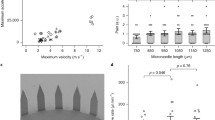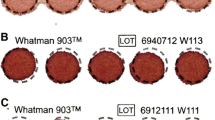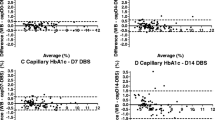Abstract
An accurate and precise 3 μL blood collection and dispensing system is presented for the preparation of dried blood spot (DBS) samples. Using end-to-end glass capillaries in conjugation with pre-punched DBS pads, a blood micro collection system was developed to eliminate the haematocrit dispersion, widely associated with DBS technology, while providing better levels of accuracy and precision during sample preparation. This methodology is compared to traditional micro-volume blood collection systems, such as a pipette and a digitally controlled analytical syringe. Results showed that % of recovery for the capillary methodology was closer to 100% across the three haematocrit (HCT) levels tested and when prepared by two users (98 to 100% for capillaries, 78 to 104% for pipette and 93 to 97% for digital syringe) attesting a higher accuracy. Additionally, by taking advantage of the capillary action mechanism to collect and dispense autonomously the desired volume of blood onto the DBS pad, coefficients of variation between two individuals were significantly lower than with standard methodologies (capillaries—0.05 to 0.77%, pipette—12.71 to 18.53% and digital syringe—0.72 to 1.77%). This alternate aspiration and dispensing methodology could be used by different users without compromising accuracy or precision when handling low volumes of blood during the pre-analytical steps.

Comparison of novel capillary dispensing methodology for dried blood spot sample preparation with pipette and digital syringe methodologies through accuracy and precision measurements of caffeine




Similar content being viewed by others
Change history
30 April 2018
The authors would like to call the reader’s attention to the following: The instrument they used to measure the volumetric precision of the dispensing devices is not called “VMS” but “PCS®”.
References
Guthrie R, Susi A. A simple phenylalanine method for detecting phenylketonuria in large populations of newborn infants. Pediatrics. 1963;32:338–43.
Burnett JE. Dried blood spot sampling: practical considerations and recommendation for use with preclinical studies. Bioanalysis. 2011;3:1099–107. https://doi.org/10.4155/BIO.11.68.
Tanna S, Lawson G. Analytical methods used in conjunction with dried blood spots. Anal Methods. 2011;3:1709–18. https://doi.org/10.1039/c1ay05160a.
Lehmann S, Delaby C, Ducos J, Hirtz C. Current and future use of “ dried blood spot ” analyses in clinical chemistry. Clin Chem Lab Med. 2013;51:1897–909. https://doi.org/10.1515/cclm-2013-0228.
Zakaria R, Allen KJ, Koplin JJ, Roche P, Greaves RF. Advantages and challenges of dried blood spot analysis by mass spectrometry across the total testing process. EJIFCC. 2016;27:288–317.
Ji QC, Liu G, D’Arienzo CJ, Olah TV, Arnold ME. What is next for dried blood spots? Bioanalysis. 2012;4:2059–65.
Liu G, Mühlhäusler BS, Gibson RA. A method for long term stabilisation of long chain polyunsaturated fatty acids in dried blood spots and its clinical application. Prostaglandins Leukot Essent Fat Acids. 2014;91:251–60. https://doi.org/10.1016/j.plefa.2014.09.009.
Wagner M, Tonoli D, Varesio E, Hopfgartner G. The use of mass spectrometry to analyze dried blood spots. Mass Spectrom Rev. 2016;35:361–438. https://doi.org/10.1002/mas.21441.
Sharma A, Jaiswal S, Shukla M, Lal J. Dried blood spots: concepts, present status, and future perspectives in bioanalysis. Drug Test Anal. 2014;6:399–414. https://doi.org/10.1002/dta.1646.
O’Mara M, Hudson-Curtis B, Olson K, Yueh Y, Dunn J, Spooner N. The effect of hematocrit and punch location on assay bias during quantitative bioana lysis of dried blood spot samples. Bioanalysis. 2011;3:2291–302.
Denniff P, Spooner N. The effect of hematocrit on assay bias when using DBS samples for the quantitative bioanalysis of drugs. Bioanalysis. 2010;2:1385–95.
Li F, Zulkoski J, Fast D, Michael S. Perforated dried blood spots: a novel format for accurate microsampling. Bioanalysis. 2011;3:2321–33. https://doi.org/10.4155/bio.11.219.
Youhnovski N, Bergeron A, Furtado M, Garofolo F. Pre-cut dried blood spot (PCDBS): an alternative to dried blood spot (DBS) technique to overcome hematocrit impact. Rapid Commun Mass Spectrom. 2011;25:2951–8. https://doi.org/10.1002/rcm.5182.
Hill JR, Valmont IJ, Wright JK. Reducing the hematocrit effect for dried blood spot analysis. Am Assoc Clin Chem Annu Meet. 9627; 2013.
Fan L, Lee JA. Managing the effect of hematocrit on DBS analysis in a regulated environment. Bioanalysis. 2012;4:345–7. https://doi.org/10.4155/bio.11.337.
Kip AE, Kiers KC, Rosing H, Schellens JHM, Beijnen JH, Dorlo TPC. Volumetric absorptive microsampling (VAMS) as an alternative to conventional dried blood spots in the quantification of miltefosine in dried blood samples. J Pharm Biomed Anal. 2016;135:160–6. https://doi.org/10.1016/j.jpba.2016.12.012.
Lenk G, Sandkvist S, Pohanka A, Stemme G, Olof Beck NR. A disposable sampling device to collect volume-measured DBS directly from a fingerprick onto DBS paper. Bioanalysis. 2015;7:2085–94. https://doi.org/10.4155/bio.15.134.
Spooner N, Olatunji A, Webbley K. Investigation of the effect of blood hematocrit and lipid content on the blood volume deposited by a disposable dried blood spot collection device. J Pharm Biomed Anal. 2018;149:419–24. https://doi.org/10.1016/j.jpba.2017.11.036.
Leuthold LA, Heudi O, Déglon J, Raccuglia M, Augsburger M, Picard F, et al. New microfluidic-based sampling procedure for overcoming the hematocrit problem associated with dried blood spot analysis. Anal Chem. 2015;87:2068–71. https://doi.org/10.1021/ac503931g.
Denniff P, Spooner N. Volumetric absorbtive micro sampling (VAMS): a novel dried sample collection technique for quantitative bioanalysis. Anal Chem. 2014;86:8489–95. https://doi.org/10.1021/ac5022562.
Verplaetse R, Henion J. Hematocrit-independent quantitation of stimulants in dried blood spots: pipette versus microfluidic-based volumetric sampling coupled with automated flow-through desorption and on-line SPE-LC-MS/MS bioanalysis. Anal Chem. 2016;88:6789–96. https://doi.org/10.1021/acs.analchem.6b01190.
Li W, Tse FLS. Dried blood spot sampling in combination with LC-MS/MS for quantitative analysis of small molecules. Biomed Chromatogr. 2010;24:49–65. https://doi.org/10.1002/bmc.1367.
Wilhelm AJ, den Burger JCG, Swart EL. Therapeutic drug monitoring by dried blood spot: progress to date and future directions. Clin Pharmacokinet. 2014;53:961–73. https://doi.org/10.1007/s40262-014-0177-7.
Rowland M, Emmons GT. Use of dried blood spots in drug development: pharmacokinetic considerations. AAPS J. 2010;12:290–3. https://doi.org/10.1208/s12248-010-9188-y.
Acknowledgements and Funding information
This research was conducted by the Australian Research Council (ARC) Training Centre for Portable Analytical Separation Technologies (IC140100022). MCB is a recipient of an ARC Future Fellowship (FT130100101). RN is a recipient of an ARC ICHDR scholarship and an International Research Tuition Scholarship from the University of South Australia. Support from the University of South Australia, University of Tasmania and Trajan Scientific and Medical is gratefully acknowledged.
Author information
Authors and Affiliations
Corresponding authors
Ethics declarations
All volunteers signed a consent form stating their understanding of the experiments and protecting their privacy. Ethics approval was provided by the University of South Australia (application number: 0000036188) and by the University of Tasmania (reference number H0015476) from their respective ethics committees.
Conflict of interest
The authors declare the following competing financial interest(s): Andrew Gooley is an executive director of Trajan Scientific and Medical. Florian Lapierre is subject to intellectual property rights. All the other authors declare that they have no conflict of interest.
Rights and permissions
About this article
Cite this article
Neto, R., Gooley, A., Breadmore, M.C. et al. Precise, accurate and user-independent blood collection system for dried blood spot sample preparation. Anal Bioanal Chem 410, 3315–3323 (2018). https://doi.org/10.1007/s00216-018-0993-y
Received:
Revised:
Accepted:
Published:
Issue Date:
DOI: https://doi.org/10.1007/s00216-018-0993-y




